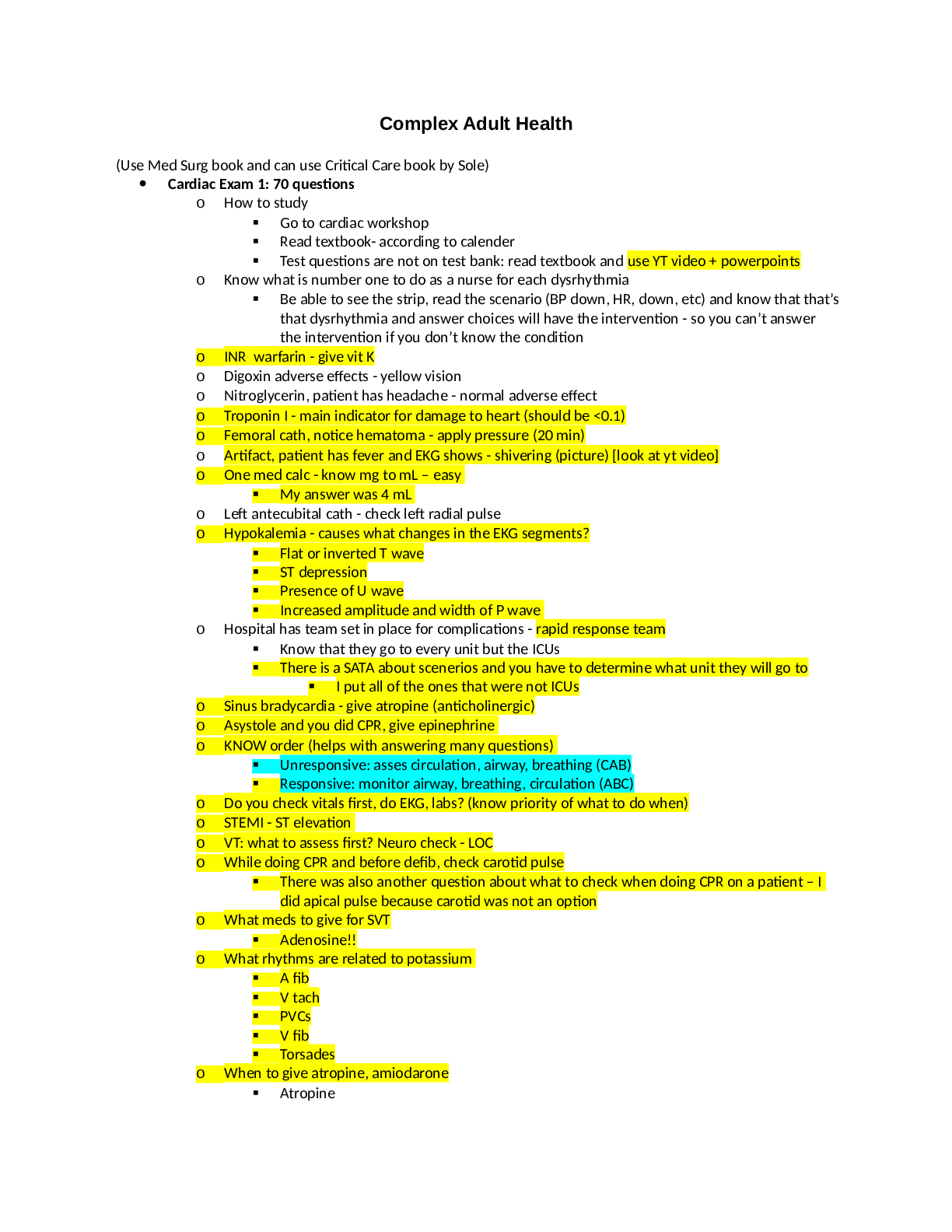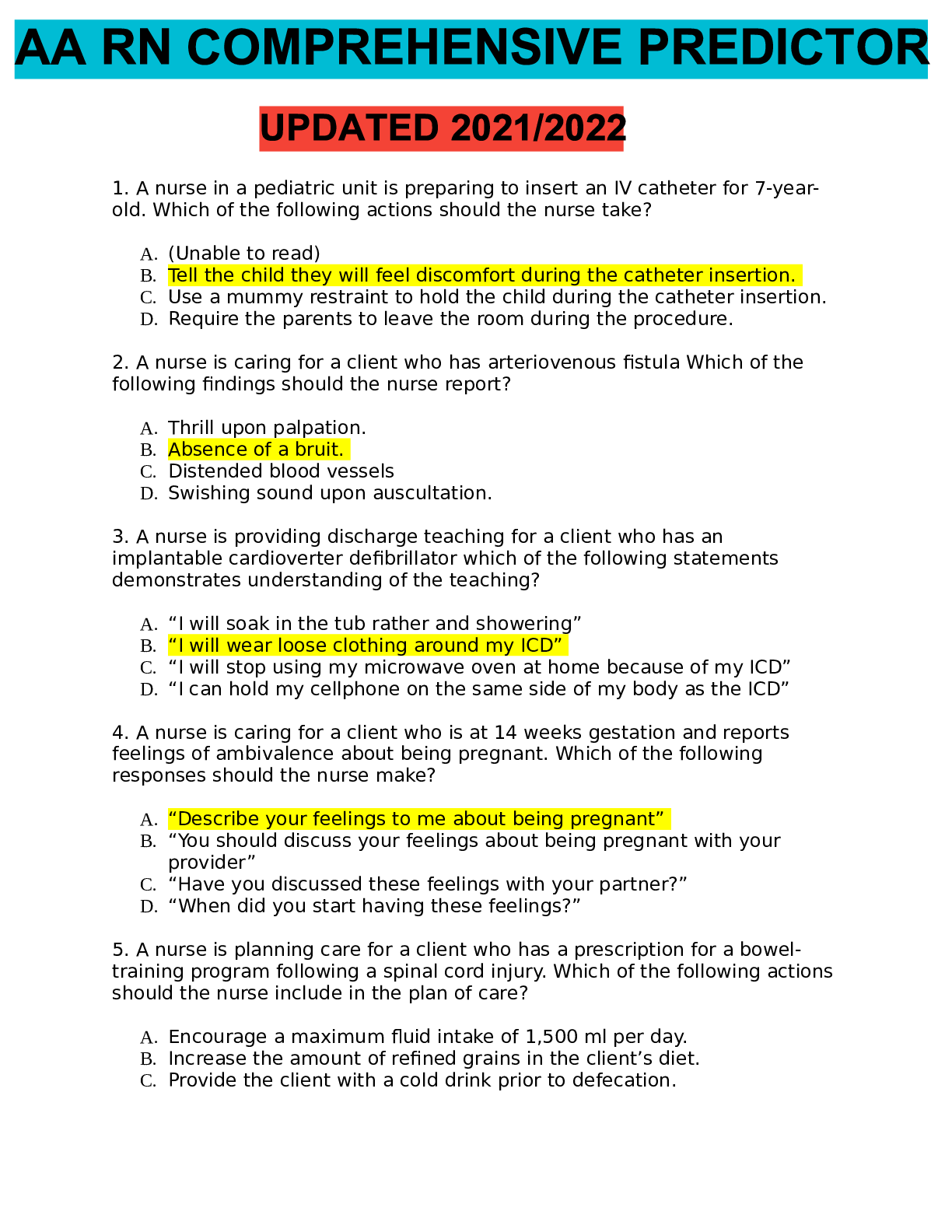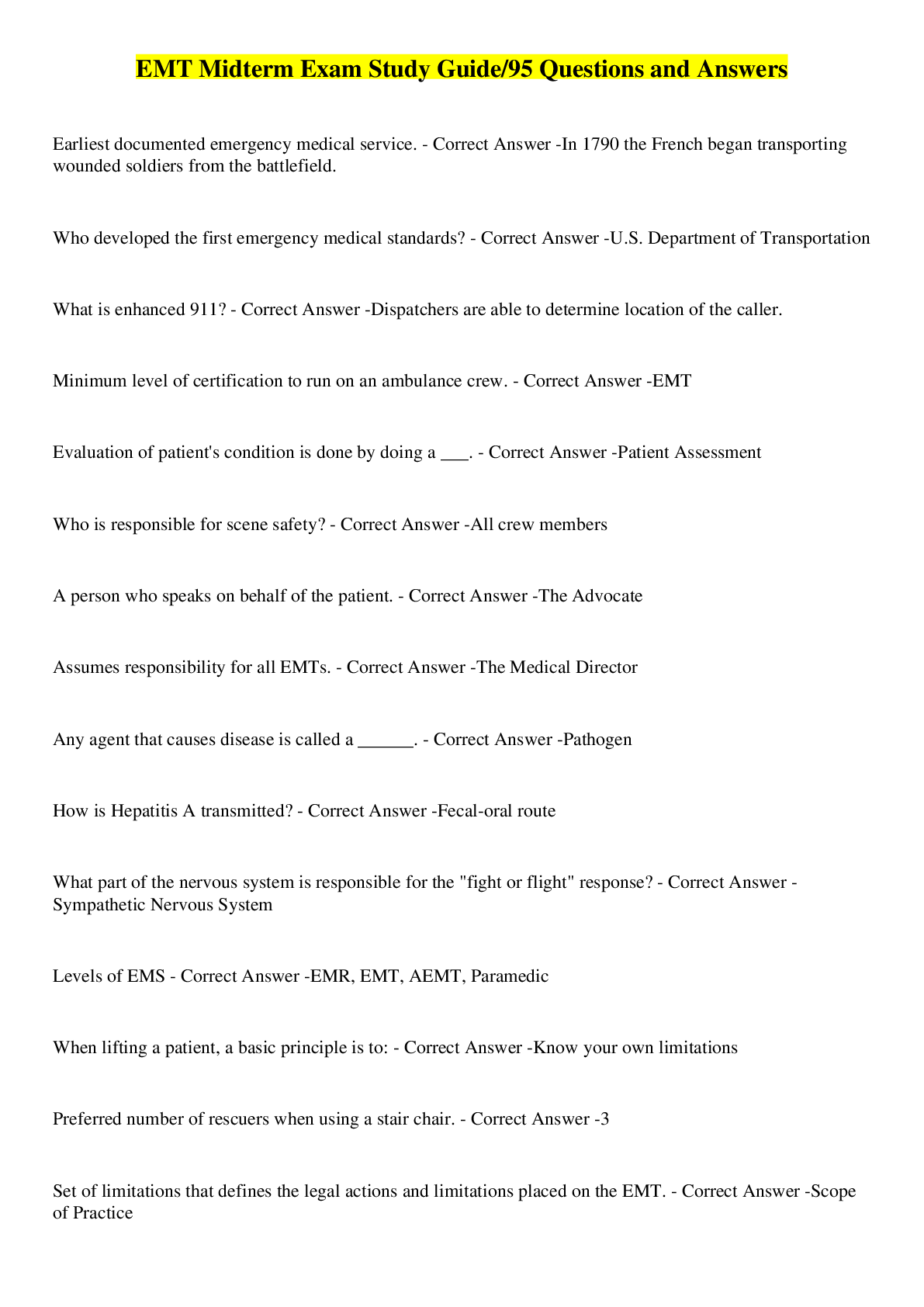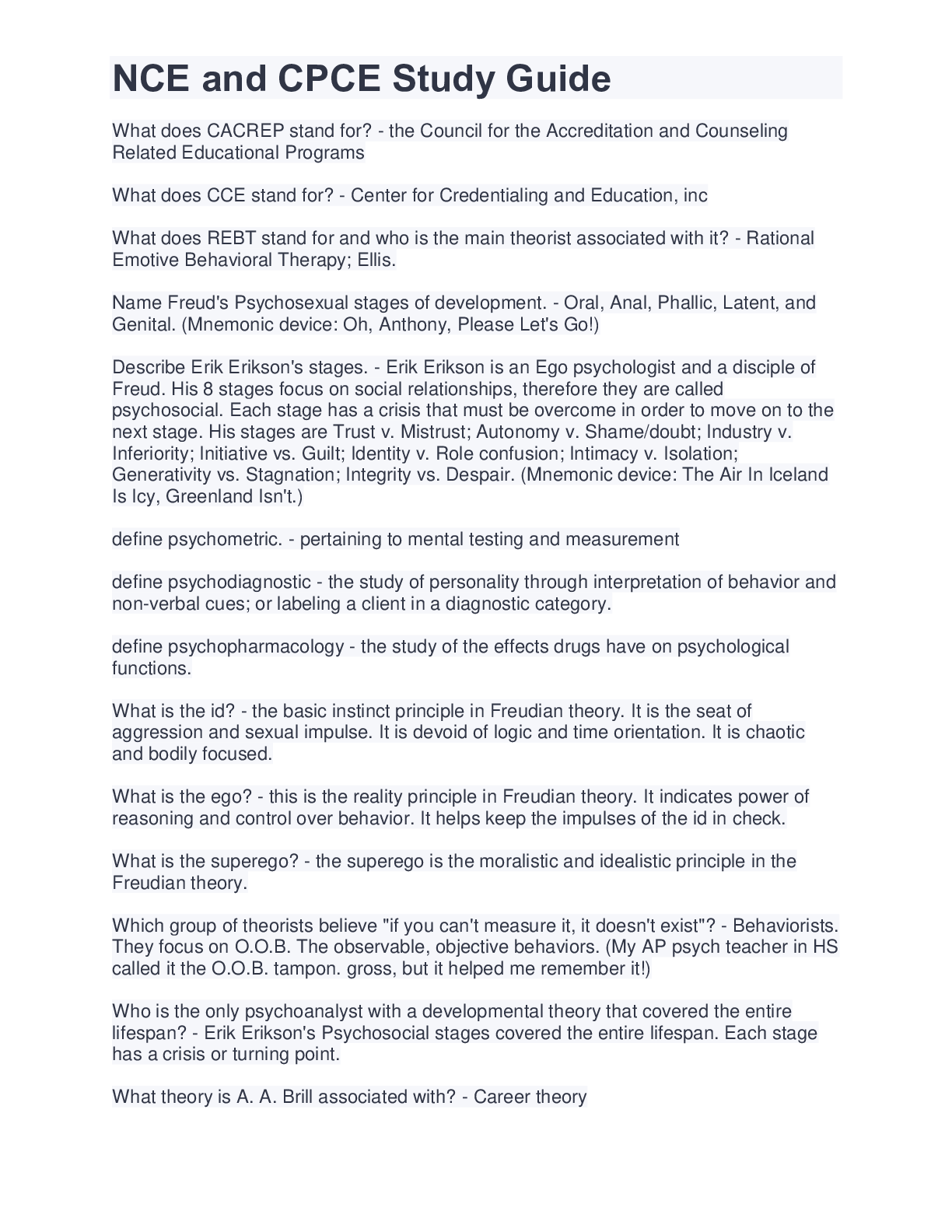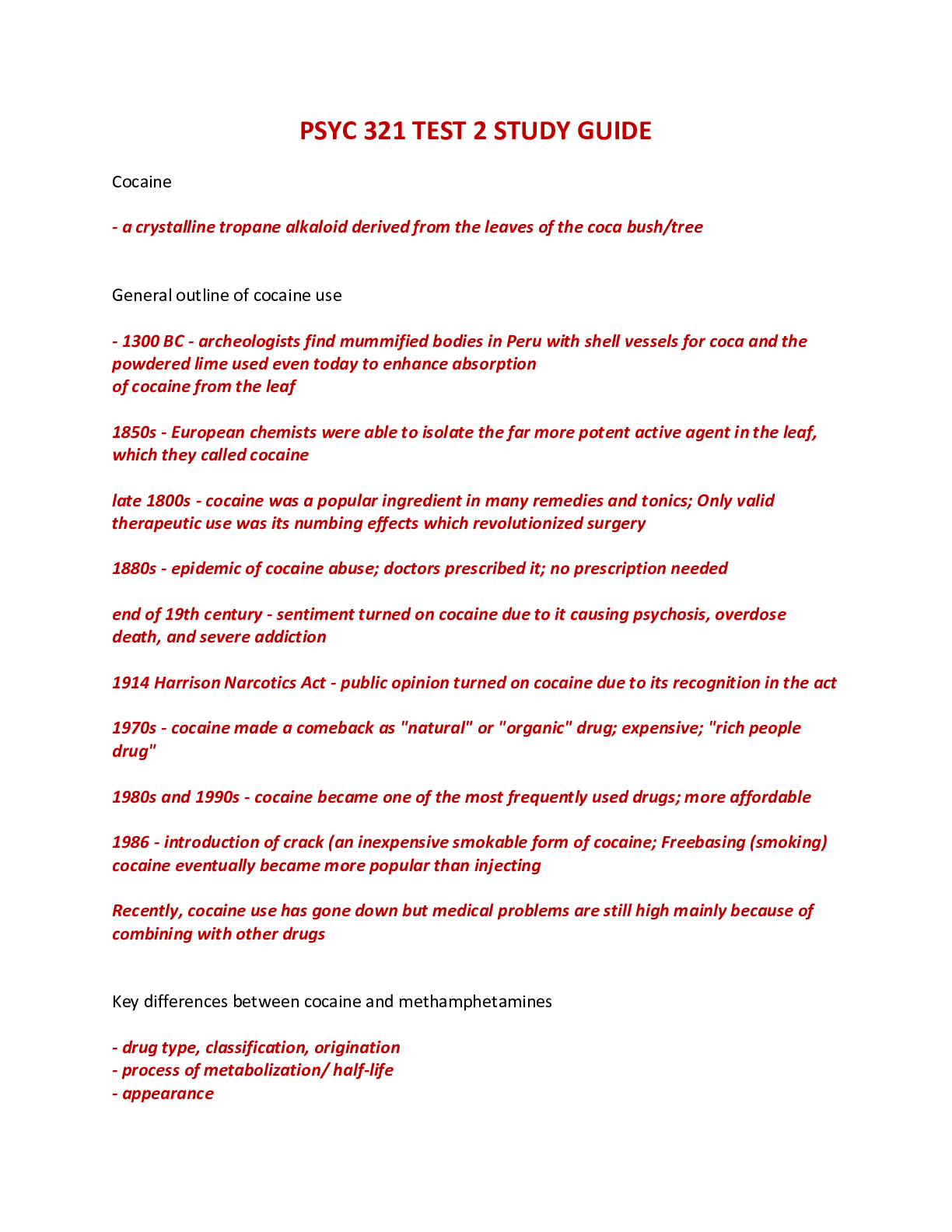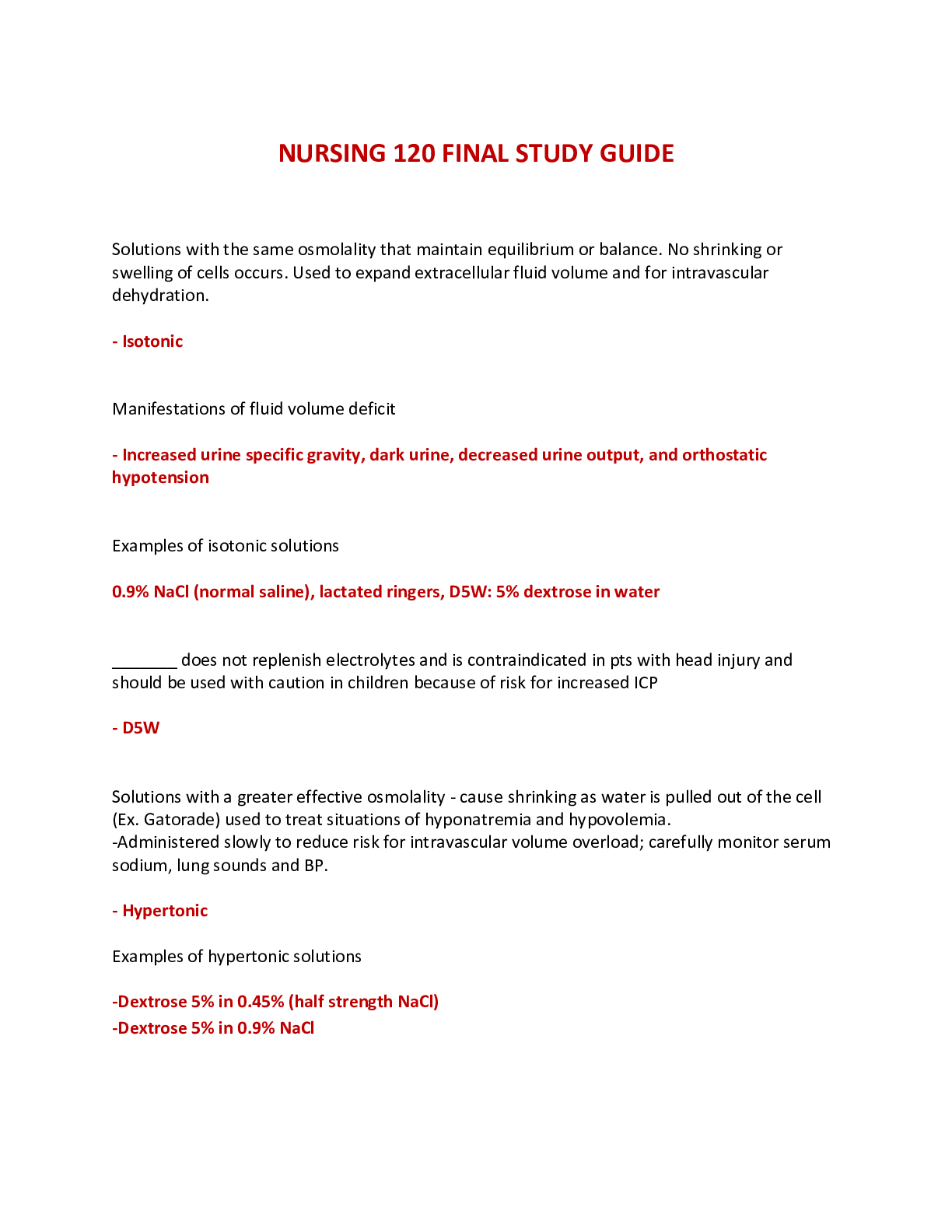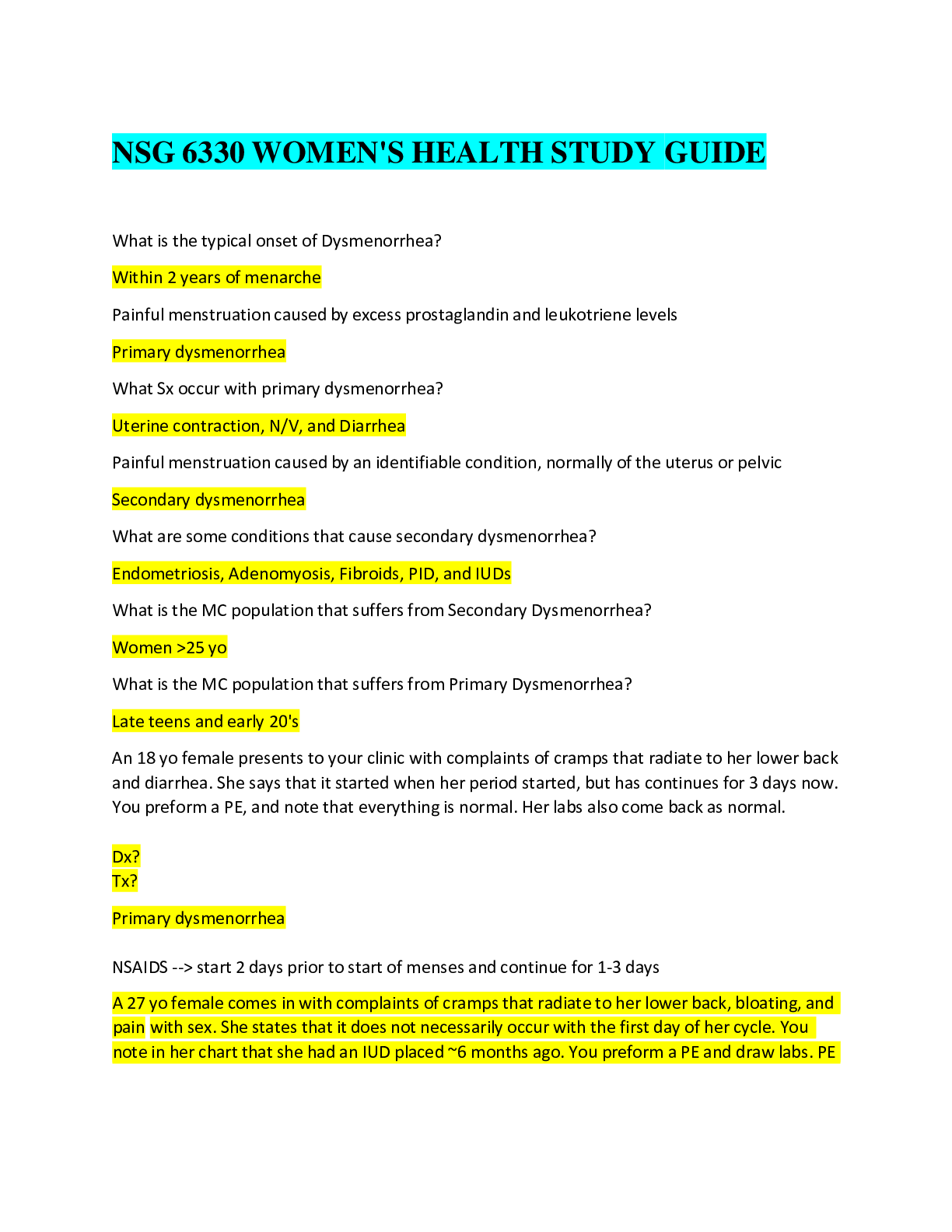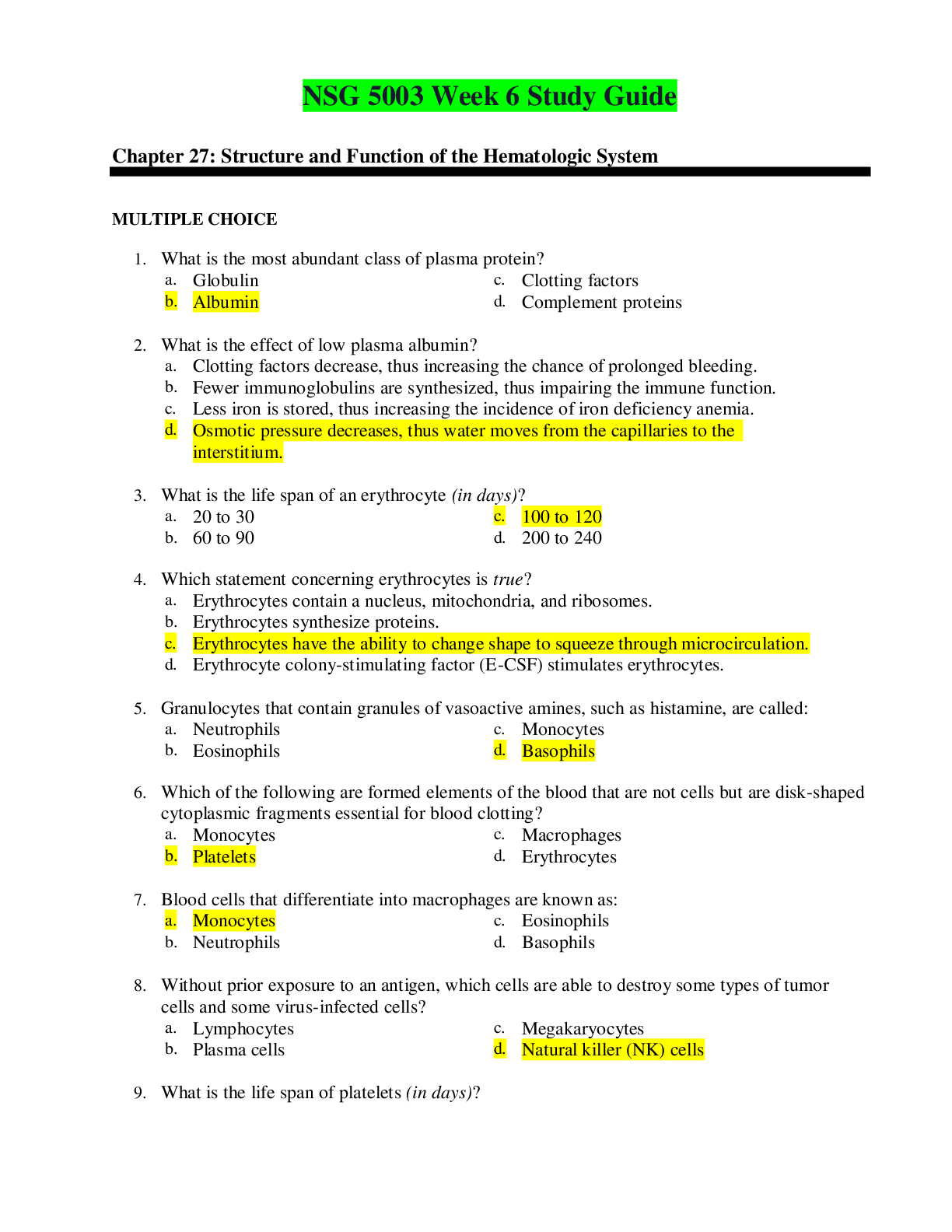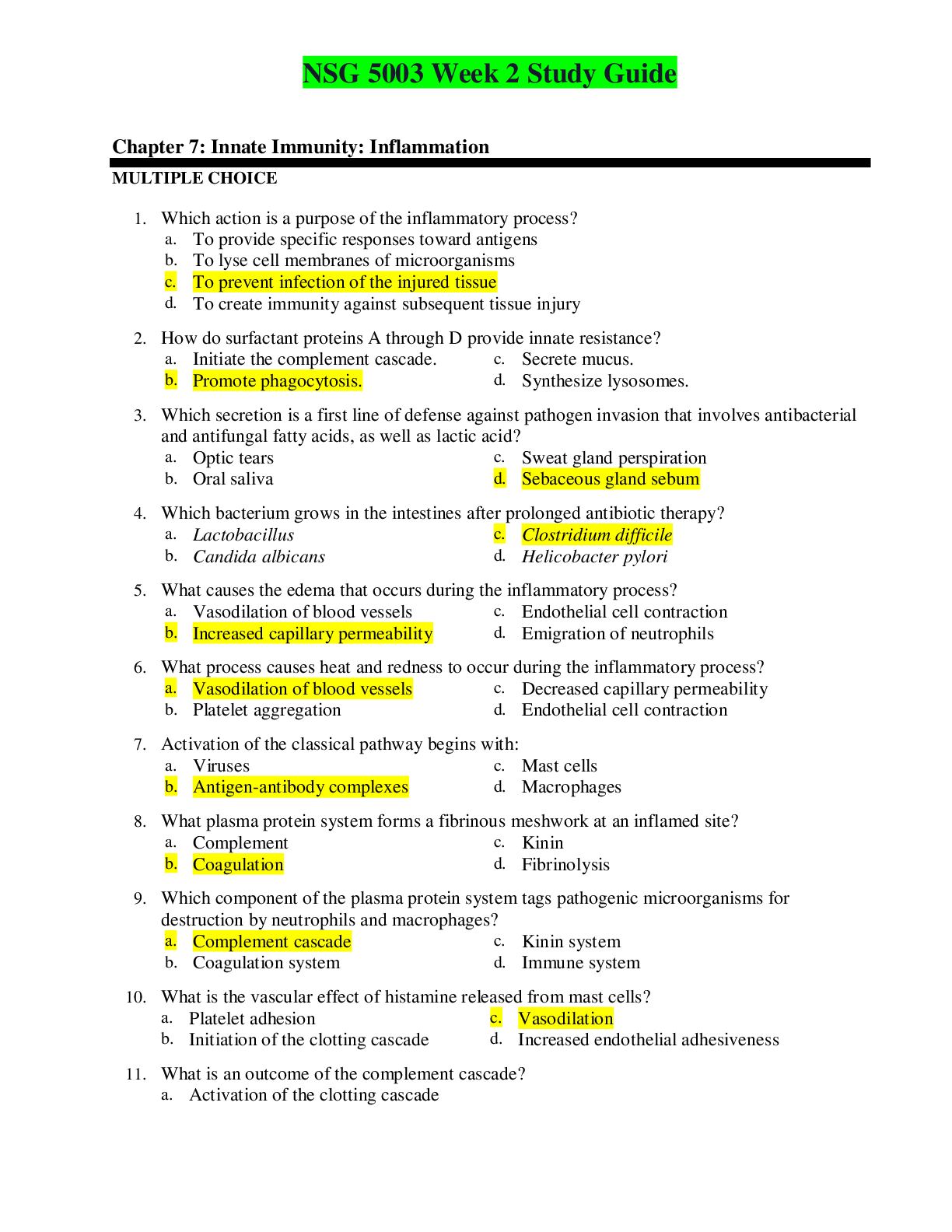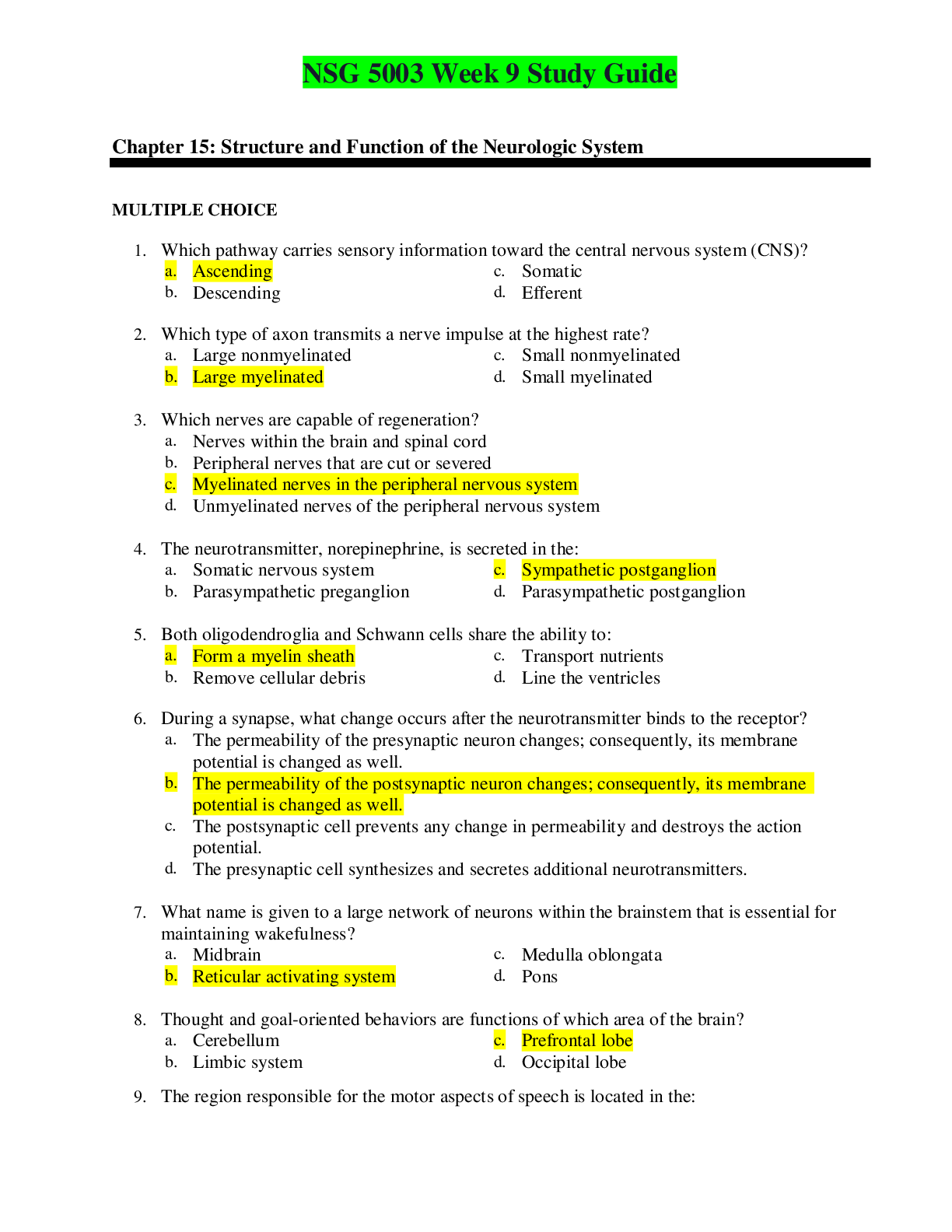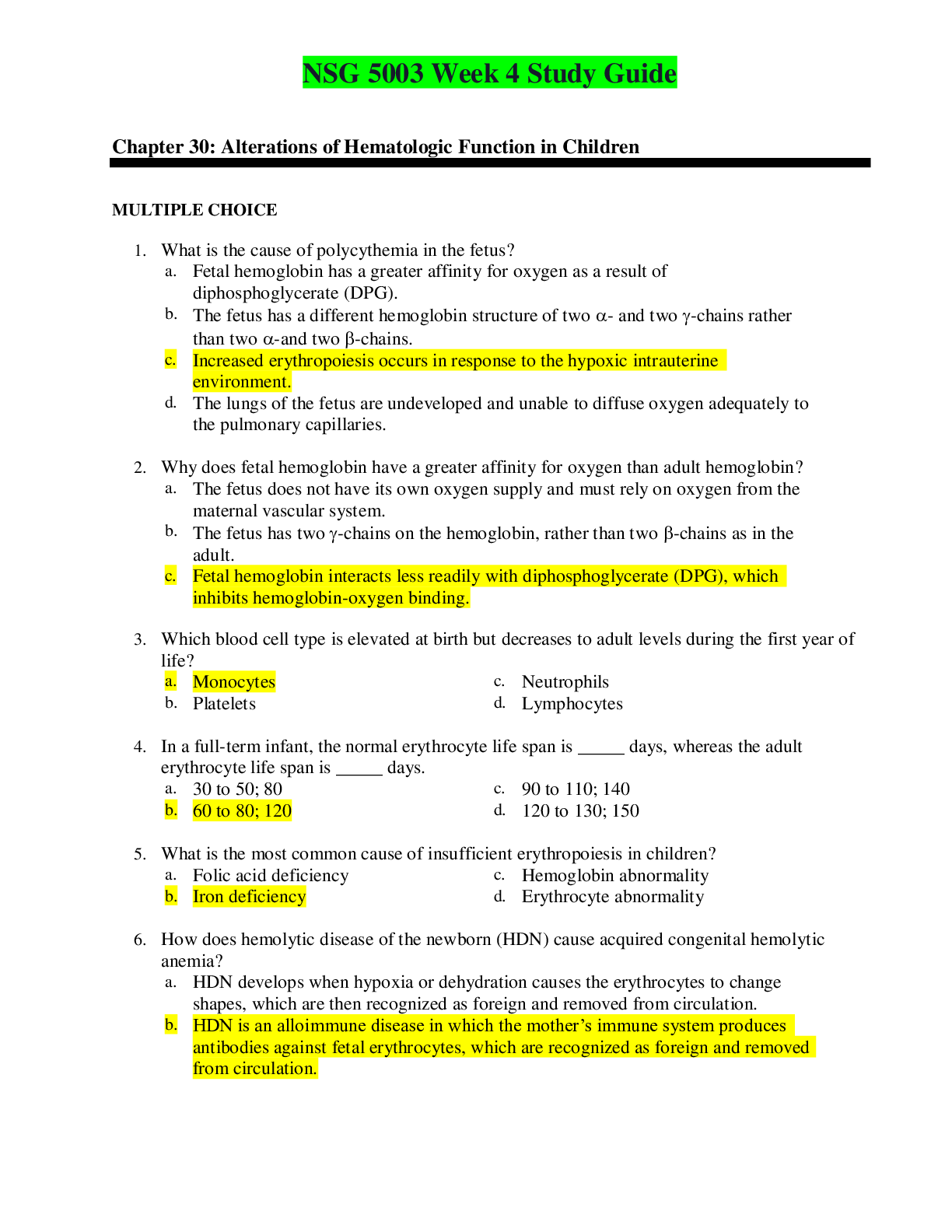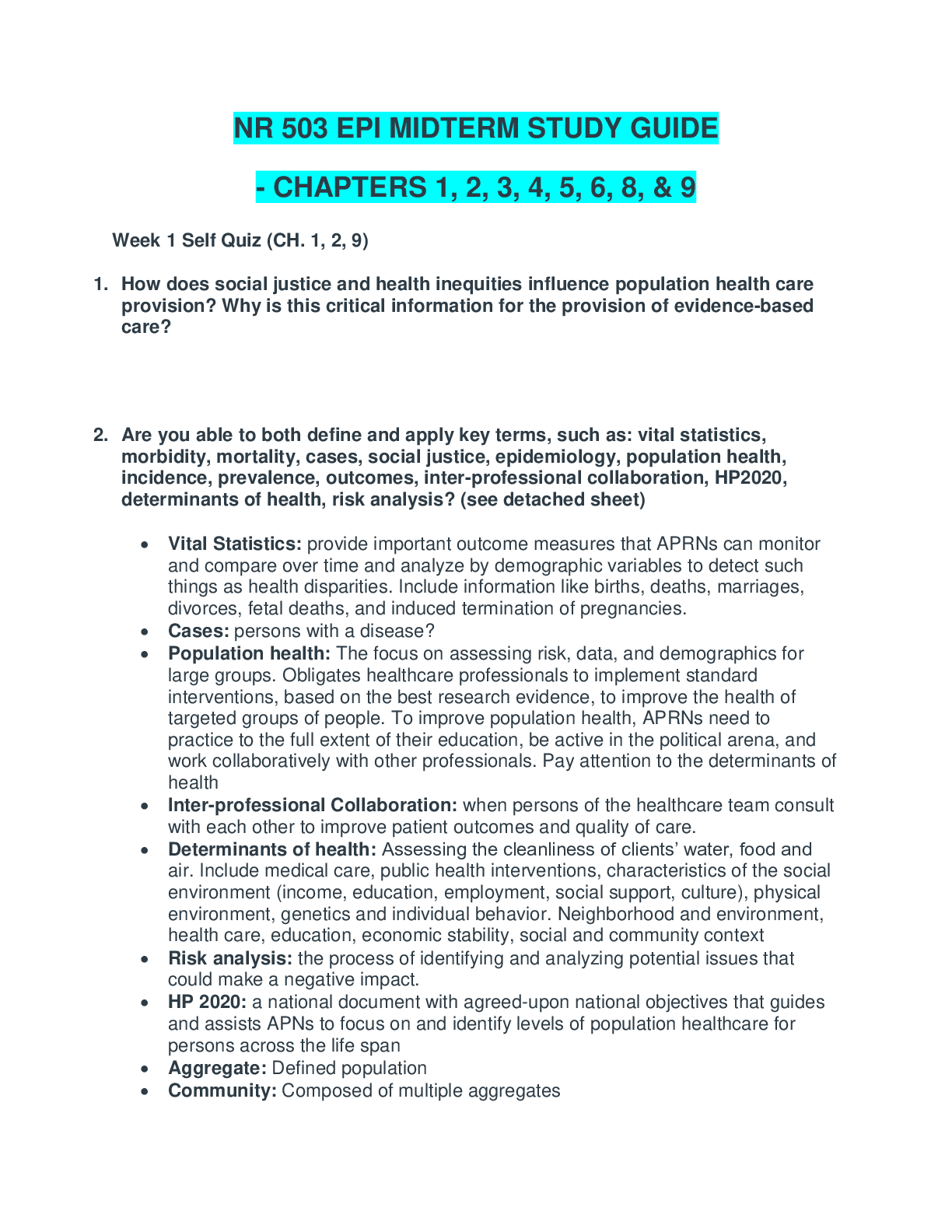*NURSING > STUDY GUIDE > NSG 5003 Week 8 Study Guide - Chapter 24 - 26 (All)
NSG 5003 Week 8 Study Guide - Chapter 24 - 26
Document Content and Description Below
NSG 5003 Week 8 Study Guide Chapter 24: Alterations of the Female Reproductive System MULTIPLE CHOICE 1. In 95% of children of delayed puberty, the problem is caused by: 2. What is the... first sign of puberty in girls? 3. Which type of precocious puberty causes the child to develop some secondary sex characteristics of the opposite sex? 4. The release of which chemical mediator causes primary dysmenorrhea? 5. Considering the pathophysiologic characteristics of primary amenorrhea, what anatomic structure is involved in compartment II? 6. Considering the pathophysiologic characteristics of primary amenorrhea, what anatomic structure is involved in compartment IV? 7. Which condition is considered a clinical cause of amenorrhea? 8. Clinical manifestations that include irregular or heavy bleeding, the passage of large clots, and the depletion of iron stores support which diagnosis? 9. What statement concerning the pathogenetic mechanisms of polycystic ovarian syndrome (POS) is true? 10. What is the leading cause of infertility in women? 11. Considering the mediating factors of premenstrual syndrome (PMS), which medication may be used either continually or only during the menstrual period as a treatment for the condition? 12. Which statement regarding pelvic inflammatory disease (PID) is true? 13. When a woman’s uterus is assessed as protruding through the entrance of the vagina to the hymen, which grade of prolapse does this indicate? 14. Which term is used to identify the descent of the posterior bladder and trigone into the vaginal canal? 15. What type of cyst develops when an ovarian follicle is stimulated but no dominant follicle develops and completes the maturity process? 16. Which term is used to identify benign uterine tumors that develop from smooth muscle cells in the myometrium and are commonly called uterine fibroids? 17. What theory is used to describe the cause of endometriosis? 18. Which virus is a precursor for developing cervical intraepithelial neoplasia (CIN) and cervical cancer? 19. Which description is used when a progressive neoplastic change involves the full epithelial thickness of the cervix? 20. Which factor increases the risk for ovarian cancer after the age of 40 years? 21. Infertility is defined as the inability to conceive after how many months of unprotected intercourse with the same partner? 22. Which of the following is not considered a cause of galactorrhea? 23. Fluid-filled squishy sacs characterize which breast disorder? 24. What are typical findings on breast palpation of a woman diagnosed with simple fibroadenoma? 25. Which benign breast tumor affects postmenopausal women and is characterized by the principal lactiferous ducts becoming dilated and filled with cellular debris? 26. The majority of the small percentage of ovarian cancers that are associated with a known pattern of inheritance are associated with: 27. What is usually the first clinical manifestation of breast cancer? Chapter 25: Alterations of the Male Reproductive System MULTIPLE CHOICE 1. In the 95% of those with delayed puberty, the problem is caused by which condition? 2. What is the first sign of puberty in boys? 3. Which type of precocious puberty causes the child to develop some secondary sex characteristics of the opposite sex? 4. What term is used to identify a condition in which the foreskin cannot be retracted over the glans penis? 5. What term is used to identify a fibrotic condition that causes lateral curvature of the penis during erection, which is associated with a local vasculitis-like inflammatory reaction and decreased tissue oxygenation? 6. What term is used to identify an inflammation of the glans penis? 7. Cryptorchidism can be defined as which of the following? 8. What is the most common infectious cause of orchitis and one that usually affects postpubertal boys? 9. The risk of which cancer is greater if the man has a history of cryptorchidism? 10. What are the clinical manifestations of testicular cancer? 11. How does the epididymis become infected? 12. Symptoms of benign prostatic hyperplasia (BPH) are a result of which pathophysiologic condition? 13. Which infection has clinical manifestations that include the sudden onset of malaise, low back pain, and perineal pain with high fever and chills, dysuria, nocturia, and urinary retention? 14. Priapism has been associated with the abuse of what substance? 15. Which age group should be targeted for testicular cancer education and screening? 16. What is the reason breast cancer in men has such a poor prognosis? Chapter 26: Sexually Transmitted Infections MULTIPLE CHOICE 1. What unique factor causes adolescent girls to have a high risk for sexually transmitted infections (STIs)? 2. How is gonorrhea transmitted from a pregnant woman to her fetus? 3. Which statement is false about the factors that facilitate the ascent of gonococci into the uterus and fallopian tubes? 4. In women, what is the usual site of original gonococcal infection? 5. What is the primary site for uncomplicated local gonococci infections in men? 6. What local complication of a gonococcal infection is diagnosed in approximately 10% of affected women? 7. Which laboratory test is considered adequate for an accurate and reliable diagnosis of gonococcal urethritis in a symptomatic man? 8. How does an established gonococcal infection usually express itself in newborns? 9. What is the major concern regarding the treatment of gonococci infections? 10. Which sexually transmitted infection frequently coexists with gonorrhea? 11. During which stage of syphilis do bloodborne bacteria spread to all the major organ systems? 12. In which stage of syphilis would the following clinical manifestations be found: destructive skin, bone and soft tissue lesions, aneurysms, heart failure, and neurosyphilis? 13. Which organism is responsible for the development of syphilis? 14. Which is a characteristic lesion of secondary syphilis? 15. By which method is the organism that causes syphilis best identified? 16. When a patient has small, vesicular lesions that last between 10 and 20 days, which sexually transmitted infection is suspected? 17. Which statement is false regarding the risk of transmission of the herpes simplex virus (HSV) from mother to fetus? 18. During the latent period of a herpes virus infection, where in the host cell is the genome of the virus maintained? 19. During reactivation (release from latency), herpes virus genomes are transported through which nerves to the dermal surface? 20. Which statement provides the most accurate information regarding the transmission of herpes simplex virus (HSV)? 21. Which drug may be prescribed orally for outbreak management of herpes simplex viral (HSV) infections? 22. Which of the following causes condylomata acuminata or genital warts? 23. Which treatment is used for trichomoniasis? 24. A woman diagnosed with trichomoniasis asks if her sexual partner should be treated as well. What is the appropriate response? 25. Which microorganism is sexually transmitted, primarily by homosexual men, through infected feces? 26. Which hepatitis virus is known to be sexually transmitted? 27. Which sexually transmitted disease occasionally causes clinical manifestations of scant intermittent penile discharge, slight pruritus, and mild dysuria? [Show More]
Last updated: 2 years ago
Preview 1 out of 8 pages
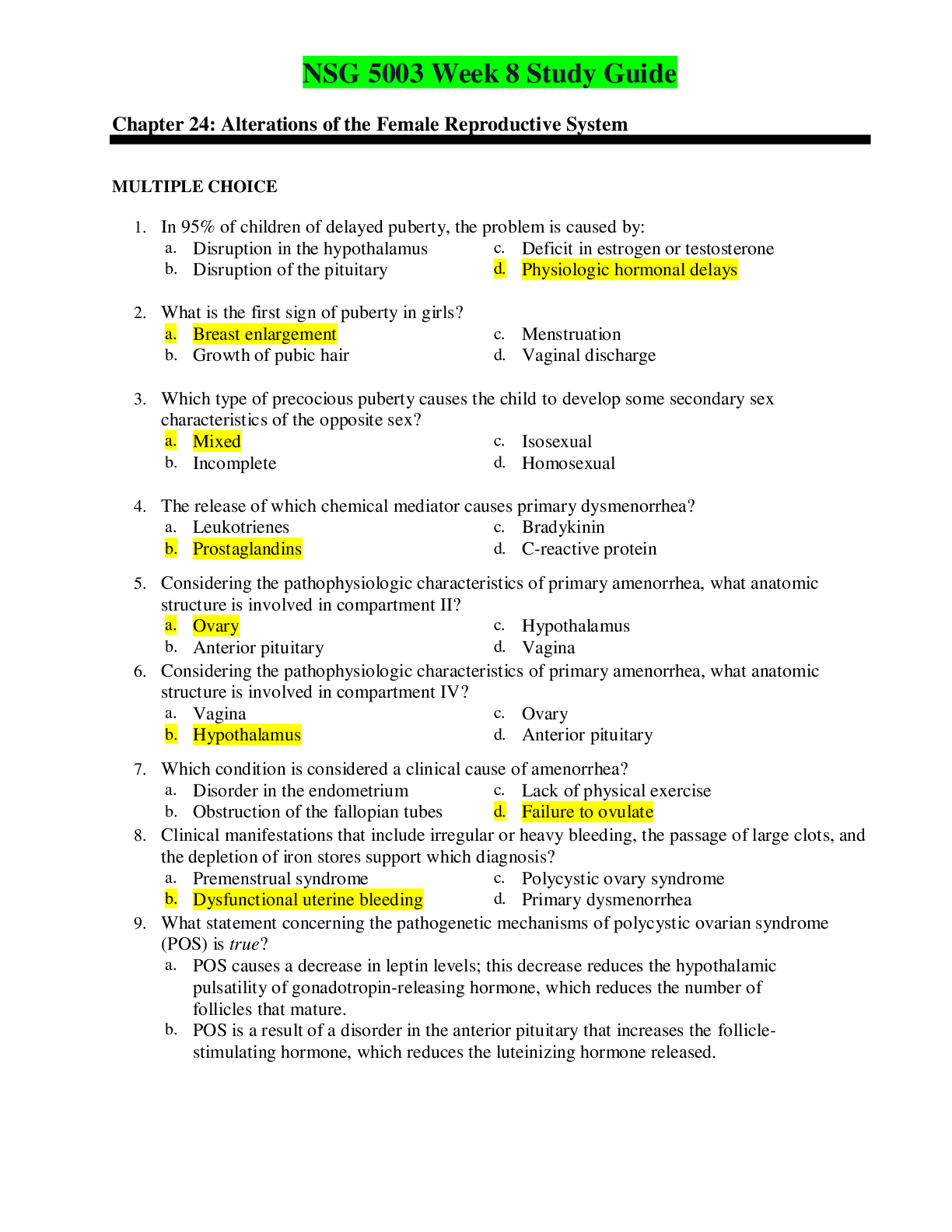
Buy this document to get the full access instantly
Instant Download Access after purchase
Buy NowInstant download
We Accept:

Also available in bundle (1)

NSG 5003 STUDY GUIDES
Week 4 Study Guide - Chapter 30 -32| Week 9 Study Guide - Chapter 15, 17 -20|Week 2 Study Guide - Chapter 7 - 11|Study Guide - Chapter 1, 2 & 3| Week 6 Study Guide - Chapter 27 - 30|Week 8 Study Guide...
By Ajay25 4 years ago
$42
7
Reviews( 0 )
$13.50
Can't find what you want? Try our AI powered Search
Document information
Connected school, study & course
About the document
Uploaded On
Feb 16, 2021
Number of pages
8
Written in
Additional information
This document has been written for:
Uploaded
Feb 16, 2021
Downloads
0
Views
98


